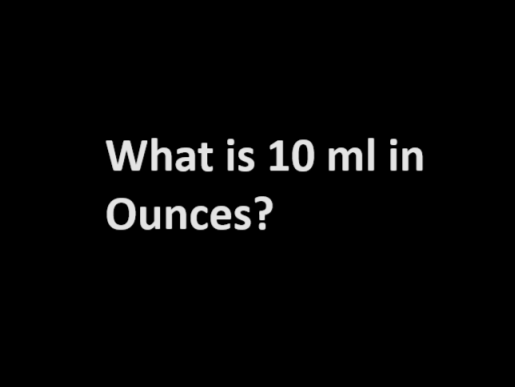What is 10 ml in Ounces?
Metric and Imperial systems are the two most commonly used systems of measurement. While the metric system is widely used around the world because of its simplicity and consistency, the imperial system is still predominant in the United States of America and some other Western countries. Converting between these two systems can often lead to confusion. Hence we need to know how to convert a metric unit into its imperial counterpart and vice versa. In this article, we will learn the correct way of converting the milliliter (ml) and the fluid ounce (oz). But, Before we dive into the conversion, it is essential to learn the basic definitions of milliliters and fluid ounces.
What is Milliliters
Milliliters (denoted by mL or ml) is a unit of volume in the metric system. We usually use milliliters to measure tiny amounts of fluid or gas. One milliliter is one-thousandth of a liter or one cubic centimeter. It is a typical unit for measuring prescription doses, laboratory reagents, and other tiny amounts of liquids.
Millilitre is a unit of measurement that is part of the International System of Units (SI Units) and is used all over the world, mainly in a profession that requires precession and accuracy, for instance, scientific research and medicine.
What is Fluid Ounce
Fluid ounce (oz) is an imperial measure of volume that is predominantly used in the American customary system.
1 ounce is equal to 1/128th of a gallon in the American customary system or 1/160th of a gallon in the imperial system. This signifies that one US gallon contains 128 fluid ounces, and one imperial gallon contains 160 fluid ounces.
To put things in perspective, a normal soda can in the United States carries 12 fluid ounces, but a typical water bottle typically holds 16.9 fluid ounces. Remember that fluid ounces are a volume measurement and that a substance’s weight can vary based on its density.
Conversion Between Milliliters and Ounces
To convert milliliters (ml) to fluid ounces (fl oz), you can use the following conversion factor:
1 milliliters = 0.033814 fluid ounces
To convert any given volume from milliliters to fluid ounces, simply multiply the value in milliliters by the conversion factor.
Fluid ounces = Milliliters * 0.033814
For example, let’s say you want to convert 500 milliliters to fluid ounces:
Fluid ounces = 500 * 0.033814 = 16.907 Oz
10 ml In Ounces
As we learned above, to convert 10 milliliters (ml) to ounces (fl oz), we can use the conversion factor of 1 ml = 0.033814 ounces.
Multiplying both sides of the equation by 10 gives us:
10 ml = 0.033814 × 10
Simplifying the calculation, we find:
10 ml = 0.33814 or approximately 0.34 ounces (oz).
Therefore, 10 ml is equivalent to approximately 0.34 ounces or approximately one-third of an ounce.
Rounding and Precision
Rounding and precision are important considerations in conversions because:
Rounding simplifies the result and determines the level of accuracy and detail.
The number of decimal places used for rounding depends on the context and the significance of the conversion.
Rounding helps present the result concisely and understandably.
The required level of precision varies based on the application.
In scientific experiments or calculations requiring high accuracy, maintaining more decimal places is crucial to minimize errors.
In everyday situations or general conversions, excessive decimal places may be impractical and unnecessary.
Factors such as desired precision, significance of the conversion, and context should be considered when deciding on the appropriate level of rounding.
Financial calculations often involve rounding to ensure consistency and avoid misleading results.
Rounding introduces a small degree of error as it approximates the true value.
Practical Applications
Some practical examples or scenarios where knowing the conversion between milliliters and ounces can be useful are:
Recipe Conversions: Helps when following recipes that use both metric and imperial measurements.
International Travel and Medications: Ensures accurate dosage administration when medications are specified in different units.
Cooking and Baking: Allows seamless measurement conversion for accurate ingredient quantities.
Manufacturing and Production: Enables precise formulation and packaging in industries like pharmaceuticals and food production.
Home Brewing and Mixology: Facilitates accurate measurement for brewing beer or crafting cocktails.
Health and Fitness: Aids in tracking fluid intake or mixing protein shakes with the right measurements.
Understanding the conversion between milliliters and fluid ounces is useful for a variety of practical purposes, including recipe conversions, foreign travel, cooking, manufacturing, home brewing, and health and fitness. One can readily convert between these two units of volume by utilizing the conversion factor of 1 milliliter equals roughly 0.034 fluid ounces. The context and intended degree of accuracy should be considered when rounding and precision are used. Mastering this ratio enables precision measurement, dosage, formulation, and tracking in a variety of domains.



